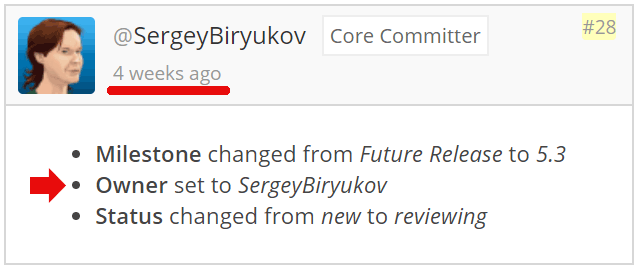NEWS
WordPress 5.3 Moves Closer to Valid HTML

WordPress announced that version 5.3 will use improved coding that will be closer to standards compliant HTML. There are good reasons why it valid HTML should be considered important for SEO. While the WordPress HTML will not be 100% valid, this update is a step in the right direction.
The release date is tentatively scheduled for November 12, 2019. For many this might seem like too little and too late. Nevertheless, WordPress is arguably the most important content management system at the moment. This means that attaining valid HTML for a website is closer now for a great many sites across the web.
WordPress 5.3 Fixes Type Attribute Issue
The improvement is focused on how script and style tags are coded. Prior to HTML5, it was mandatory to use the “type” attribute to tell browsers that the script or style was text.
HTML5 eliminated the need for the “type” attribute. The change caused HTML5 sites that continued using the “type” attribute to render as invalid HTML.
Different Levels of Validation Messages
There are different levels of validation messages. There are warnings, which are considered relatively minor and there are errors, which are more important.
This coding error resulted in a validation warning but did not trigger an error message. Perhaps because it was seen as a harmless oversight the invalid code continued to be present in WordPress.
Official WordPress Announcement
This is how the official WordPress announcement described what is changing in version 5.3:
“In HTML5, the
typeattribute is not required for the<script>and<style>tags. Including the attribute on these tags (type="text/javascript", for example) will trigger a validation warning in HTML validation tools.In WordPress 5.3, two new arguments are now supported for the
html5theme feature,scriptandstyle. When these arguments are passed, thetypeattribute will not be output for those tags.”
Why HTML Validation Matters
HTML is a programming language with rules. Initially, bots and browsers functioned best when the rules were followed. But developer demands outpaced the rules. So developers bent the rules.
Search engines and browsers needed the content so developers adapted to non-conforming HTML.
Yet, the best way to communicate data has always been to give the browsers and search engines valid HTML because when you follow the rules there is less chance of a mistake happening.
The essence of SEO, the heart of it, is to communicate information to users and search engines.
Anything that muffles your message, that makes it harder to understand your message, works against you. Invalid HTML works against your message.
Poor HTML markup does not necessarily block your message (although in certain cases it can). But it does makes it harder to communicate it.
Type Attribute Issue is Commonly Downplayed
Many in the publishing and SEO community regard the type attribute warning as a minor issue. In a discussion thread from 2017, a senior member of WebmasterWorld observed:
“Also note that it’s flagged as a “warning”, not as an “error”. That means nothing bad will happen even if you leave it unchanged; it’s more of an FYI.”

That member’s attitude of downplaying the invalid code is common throughout the industry and with good reason.
As long as Google can overlook it then this kind of problem can go unfixed. There is always something more important to focus on than a seemingly minor HTML coding error.
But there’s more to this issue in the form of what’s known as browser quirks mode.
Valid WordPress HTML Code is Important to SEO
Another member pointed out that invalid code has the potential to trigger what’s known as “quirks mode” in a browser.
Quirks mode is when a browser begins trying to interpret the invalid code in a manner that may result in a useful web page. It’s a way to compensate for bad code.
Quirks mode can cause unpredictable web page rendering and in unlucky circumstances result in a web page that does not function correctly.
This is the reason why maintaining valid HTML code is important for SEO. Part of good SEO is controlling for every aspect of how a web page renders for users and for bots.
In general, invalid code has the potential to cause a cascading series of errors that can impact speed, conversions, bounce rates and even indexing.
The potential is widely considered remote, but it can’t be ruled out.
All it takes is a script or a plugin to play badly with another script (while the browser is in quirks mode), to cause unintended consequences.
Even though the above scenario may be remote, it’s a good practice to lock down every factor that contains a potential for error. That’s good SEO.

WordPress 5.3 HTML Improvement is Important
I asked HTML and SEO expert Edward Lewis for his thoughts on WordPress fixing the type attribute error:
“It is a BIG deal. It will eliminate a gajillion warnings from validation routines. Some sites will now go green and be 100% valid since they’ve failed to heed the warnings.”
I agree with Edward Lewis. WordPress finally removing the “type” attribute in <script> and <style> tags is indeed a big deal.
WordPress Ticket Timeline
The WordPress development team has been aware of this issue since almost two years ago. A WordPress ticket was opened 23 months ago about this issue.
About three months ago Sergey Biryukov (@SergeyBiryukov) appeared to take notice and about four weeks ago updated the status of the ticket.

WordPress 5.3 Contains Many Improvements
The improvements coming in WordPress version 5.3 aren’t limited to this one fix. There are numerous changes in WP 5.3 that may be important to developers.
But this change will directly affect publishers, developers and those in the SEO community.
It’s encouraging to see the WordPress development team pushing WordPress that much closer to outputting valid HTML code. WordPress 5.3 will be good for publishers and for SEO.
Read the announcement here:
https://make.wordpress.org/core/5-3/
NEWS
OpenAI Introduces Fine-Tuning for GPT-4 and Enabling Customized AI Models

OpenAI has today announced the release of fine-tuning capabilities for its flagship GPT-4 large language model, marking a significant milestone in the AI landscape. This new functionality empowers developers to create tailored versions of GPT-4 to suit specialized use cases, enhancing the model’s utility across various industries.
Fine-tuning has long been a desired feature for developers who require more control over AI behavior, and with this update, OpenAI delivers on that demand. The ability to fine-tune GPT-4 allows businesses and developers to refine the model’s responses to better align with specific requirements, whether for customer service, content generation, technical support, or other unique applications.
Why Fine-Tuning Matters
GPT-4 is a very flexible model that can handle many different tasks. However, some businesses and developers need more specialized AI that matches their specific language, style, and needs. Fine-tuning helps with this by letting them adjust GPT-4 using custom data. For example, companies can train a fine-tuned model to keep a consistent brand tone or focus on industry-specific language.
Fine-tuning also offers improvements in areas like response accuracy and context comprehension. For use cases where nuanced understanding or specialized knowledge is crucial, this can be a game-changer. Models can be taught to better grasp intricate details, improving their effectiveness in sectors such as legal analysis, medical advice, or technical writing.
Key Features of GPT-4 Fine-Tuning
The fine-tuning process leverages OpenAI’s established tools, but now it is optimized for GPT-4’s advanced architecture. Notable features include:
- Enhanced Customization: Developers can precisely influence the model’s behavior and knowledge base.
- Consistency in Output: Fine-tuned models can be made to maintain consistent formatting, tone, or responses, essential for professional applications.
- Higher Efficiency: Compared to training models from scratch, fine-tuning GPT-4 allows organizations to deploy sophisticated AI with reduced time and computational cost.
Additionally, OpenAI has emphasized ease of use with this feature. The fine-tuning workflow is designed to be accessible even to teams with limited AI experience, reducing barriers to customization. For more advanced users, OpenAI provides granular control options to achieve highly specialized outputs.
Implications for the Future
The launch of fine-tuning capabilities for GPT-4 signals a broader shift toward more user-centric AI development. As businesses increasingly adopt AI, the demand for models that can cater to specific business needs, without compromising on performance, will continue to grow. OpenAI’s move positions GPT-4 as a flexible and adaptable tool that can be refined to deliver optimal value in any given scenario.
By offering fine-tuning, OpenAI not only enhances GPT-4’s appeal but also reinforces the model’s role as a leading AI solution across diverse sectors. From startups seeking to automate niche tasks to large enterprises looking to scale intelligent systems, GPT-4’s fine-tuning capability provides a powerful resource for driving innovation.
OpenAI announced that fine-tuning GPT-4o will cost $25 for every million tokens used during training. After the model is set up, it will cost $3.75 per million input tokens and $15 per million output tokens. To help developers get started, OpenAI is offering 1 million free training tokens per day for GPT-4o and 2 million free tokens per day for GPT-4o mini until September 23. This makes it easier for developers to try out the fine-tuning service.
As AI continues to evolve, OpenAI’s focus on customization and adaptability with GPT-4 represents a critical step in making advanced AI accessible, scalable, and more aligned with real-world applications. This new capability is expected to accelerate the adoption of AI across industries, creating a new wave of AI-driven solutions tailored to specific challenges and opportunities.
This Week in Search News: Simple and Easy-to-Read Update

Here’s what happened in the world of Google and search engines this week:
1. Google’s June 2024 Spam Update
Google finished rolling out its June 2024 spam update over a period of seven days. This update aims to reduce spammy content in search results.
2. Changes to Google Search Interface
Google has removed the continuous scroll feature for search results. Instead, it’s back to the old system of pages.
3. New Features and Tests
- Link Cards: Google is testing link cards at the top of AI-generated overviews.
- Health Overviews: There are more AI-generated health overviews showing up in search results.
- Local Panels: Google is testing AI overviews in local information panels.
4. Search Rankings and Quality
- Improving Rankings: Google said it can improve its search ranking system but will only do so on a large scale.
- Measuring Quality: Google’s Elizabeth Tucker shared how they measure search quality.
5. Advice for Content Creators
- Brand Names in Reviews: Google advises not to avoid mentioning brand names in review content.
- Fixing 404 Pages: Google explained when it’s important to fix 404 error pages.
6. New Search Features in Google Chrome
Google Chrome for mobile devices has added several new search features to enhance user experience.
7. New Tests and Features in Google Search
- Credit Card Widget: Google is testing a new widget for credit card information in search results.
- Sliding Search Results: When making a new search query, the results might slide to the right.
8. Bing’s New Feature
Bing is now using AI to write “People Also Ask” questions in search results.
9. Local Search Ranking Factors
Menu items and popular times might be factors that influence local search rankings on Google.
10. Google Ads Updates
- Query Matching and Brand Controls: Google Ads updated its query matching and brand controls, and advertisers are happy with these changes.
- Lead Credits: Google will automate lead credits for Local Service Ads. Google says this is a good change, but some advertisers are worried.
- tROAS Insights Box: Google Ads is testing a new insights box for tROAS (Target Return on Ad Spend) in Performance Max and Standard Shopping campaigns.
- WordPress Tag Code: There is a new conversion code for Google Ads on WordPress sites.
These updates highlight how Google and other search engines are continuously evolving to improve user experience and provide better advertising tools.
Facebook Faces Yet Another Outage: Platform Encounters Technical Issues Again

Uppdated: It seems that today’s issues with Facebook haven’t affected as many users as the last time. A smaller group of people appears to be impacted this time around, which is a relief compared to the larger incident before. Nevertheless, it’s still frustrating for those affected, and hopefully, the issues will be resolved soon by the Facebook team.
Facebook had another problem today (March 20, 2024). According to Downdetector, a website that shows when other websites are not working, many people had trouble using Facebook.
This isn’t the first time Facebook has had issues. Just a little while ago, there was another problem that stopped people from using the site. Today, when people tried to use Facebook, it didn’t work like it should. People couldn’t see their friends’ posts, and sometimes the website wouldn’t even load.
Downdetector, which watches out for problems on websites, showed that lots of people were having trouble with Facebook. People from all over the world said they couldn’t use the site, and they were not happy about it.
When websites like Facebook have problems, it affects a lot of people. It’s not just about not being able to see posts or chat with friends. It can also impact businesses that use Facebook to reach customers.
Since Facebook owns Messenger and Instagram, the problems with Facebook also meant that people had trouble using these apps. It made the situation even more frustrating for many users, who rely on these apps to stay connected with others.
During this recent problem, one thing is obvious: the internet is always changing, and even big websites like Facebook can have problems. While people wait for Facebook to fix the issue, it shows us how easily things online can go wrong. It’s a good reminder that we should have backup plans for staying connected online, just in case something like this happens again.
-

 SEO7 days ago
SEO7 days agoGoogle’s Revamped Documentation Shows 4 Reasons To Refresh Content
-
SEARCHENGINES5 days ago
Daily Search Forum Recap: August 26, 2024
-

 SEARCHENGINES7 days ago
SEARCHENGINES7 days agoGoogle Ranking Bug Fixed, August Core Update Swings, AI Overviews, Google Ads Bug & More
-

 WORDPRESS7 days ago
WORDPRESS7 days agoHow to Secure Your WordPress Store
-
SEARCHENGINES4 days ago
Daily Search Forum Recap: August 27, 2024
-

 AFFILIATE MARKETING7 days ago
AFFILIATE MARKETING7 days agoBusiness Owners are Batting 1,000 With This All-in-One Management Hub
-

 SEARCHENGINES6 days ago
SEARCHENGINES6 days agoGoogle Migrating All To Google Merchant Center Next By September
-

 WORDPRESS5 days ago
WORDPRESS5 days ago9 Best Elementor Alternatives 2024 (Faster Page Builders)












